Biscoitos de Maizena are a popular Brazilian cookie that melt in your mouth. Unlike most cookies, these cookies use cornstarch as its primary ingredient.
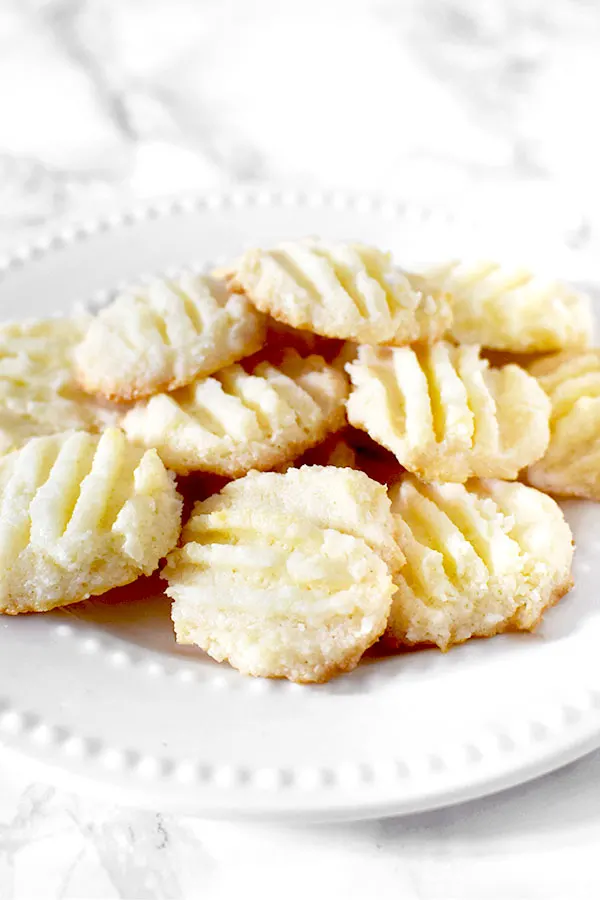
"Biscoitos de maizena" literally translates as "cornstarch cookies".
You can make this recipe two ways, with or without coconut. Not all recipes call for coconut, but most do and it is a very popular version.
However, if you do not have coconut on hand, like I didn’t, don’t worry about it. The Biscoitos de Maizena will still be delicious.
However, instead of having a coconut flavor to them, they will simply taste like a sweet cookie.
While cornstarch, otherwise known as cornflour, is the main ingredient, the recipe also calls for flour. Flour in this case helps stabilize the cornstarch so it becomes more cookie-like.
If you want to leave it out to make it gluten free, you can, but replace it with an egg. If you don’t, you just will be eating sweetened cornstarch, and trust me, you don’t want that texture in your mouth.
Surprisingly, most, if not all of the Brazilian recipes I read, called for margarine and not butter. Since I avoid margarine whenever I can help it, my recipe calls for oil instead.
If you’d like to use butter, use one cup of butter instead of a three quarters cup of oil.
Making Cookies with Oil
Making cookies with oil is a little bit different than making cookies with butter.
When making cookies with butter, the butter is often creamed with sugar first. Cookies made with oil don't have this step, so they could require a little kneading.
Also, since butter is about 80% fat and 20% water, and oil is 100% fat, you need less oil than you do butter.
However, that could lead to cookie dough with oil being drier to work with. This is not the case with cookies like crinkle cookies, but in most cases, it is.
So, what I like to do is add back some of the water until I get a similar consistency to cookie dough made with butter.
I do this by adding a bit of water at a time and mixing it in before adding a little more until I get the right consistency. This is because I usually find adding the full amount would make the cookie dough too wet.
Do Oil Cookies Need to be chilled?
In most cases, I don't find chilling cookies made with oil necessary.
It is helpful for shaping cookies if you've made them too wet, but kneading in a little flour usually is easier to work with than chilled dough.
The one exception is for cookies you plan to cut out, like sugar cookies or gingerbread cookies.
Dough you need to roll out and cut with cookie cutters will roll out easier if chilled first.
Cornstarch
Starch is a natural component of almost all grains and some fruits and vegetables.
One of starch’s compelling properties is its ability to absorb and retain lots of liquid.
Starches are incredibly versatile ingredients. They cause the liquid to thicken and add moisture as well as a tender and delicate texture in baked goods.
They can also be combined with water as an egg replacement for eggless and vegan recipes, working as a binder and to add moisture.
In addition, starches are sometimes used to make a coating for frying, which creates a crispy texture on fried foods like fried chicken.
It's also not uncommon to find starch used as a stabilizer.
Cornstarch is one of the most versatile starches there are. It is a terrific ingredient for thickening sauces, puddings, soups, and pie fillings and is also used in many baked good recipes.
Cornstarch Uses
Cornstarch is an underrated and underused ingredient in home kitchens. Here are a number of ways cornstarch can be used:
Cornstarch for thickening soups, stews, and gravies
Cornstarch is often used as a thickening agent when added to soups, stews, and gravies.
This is usually done by making a slurry which is then added to whatever is in need of thickening.
Cornstarch in baked goods
Starch helps keep breads, cakes, quick breads, muffins, cupcakes, and brownies fresh by absorbing and holding liquid.
For breads, you can replace up to ¼ cup of all-purpose flour with cornstarch out of every three cups of flour.
For cakes, quick breads, muffins, and cupcakes, you can replace 2 tablespoons out of every cup of all-purpose flour.
Cornstarch in Cookies
Cornstarch gives cookies a soft center, helps prevent them from spreading, and adds chewiness.
Add ½ to 1 teaspoon of cornstarch per cup of flour called for in the recipe.
Cornstarch for Chewy Brownies
For chewy brownies that taste like those from the box, add 1 tablespoon of cornstarch per ½ cup of flour.
How to substitute Cornstarch
Cornstarch is one of a number of starches available - though it tends to be the easiest to find.
The best alternative to cornstarch in my opinion is potato starch.
You should substitute potato starch for cornstarch in a 1:1 ratio. This means if you need 1 tablespoon of cornstarch, use 1 tablespoon of potato starch instead.
BAKING WITH OIL
Baking with oil produces a moister and tenderer texture compared to that of baked goods made with butter.
Cakes, cupcakes, muffins, and quick breads also tend to bake up taller with a better crumb and stay moist and tender much longer than recipes made with butter.
Also, since oil weighs less than butter, baked goods made with oil have a lighter texture than those made with butter.
In addition, butter is usually only 80% fat, whereas oil is 100% fat. As a result, the water that's present in butter strengthens the gluten in the flour, making it more dense and less tender than baked goods made with oil.
Oil is often used in recipes where a lighter and airier texture is desired or in recipes that call for both oil and butter, in order to have the benefits of oil while keeping the butter flavor.
Which Type Of Oil to Use
I use neutral oils like canola oil, safflower oil, and vegetable oil. You can also use stronger oils like olive oil and coconut oil, but they may change the taste somewhat.
Is it better to use canola oil or olive oil?
Canola oil is relatively cheap and, due to its lack of flavor and high smoke point, is very versatile.
Olive oil, on the other hand, is healthier. Also, its stronger flavor makes it preferable in recipes such as focaccia, which require its distinct taste.
Baking with Oil Conversion Chart
If you want to convert your butter recipes to oil recipes, take a look at my baking with oil - butter to oil conversion chart.
How to store Oil
Store oils in a cool, dark place to prevent them from becoming rancid.
If refrigerated, some oils, like olive oil, may solidify, but will return to a liquid state at room temperature.
Coconut oil begins to solidify in temperatures under 76ºF or 25ºC.
HOW TO MEASURE FLOUR AND OTHER DRY INGREDIENTS
The best way to measure dry ingredients is with a scale. However, this is not commonly done in the United States, where dry measuring cups are used instead.
To measure most dry ingredients, first spoon them into a dry measuring cup and then level off the measuring cup with an upside-down butter knife.
Make sure not to pack it down because it can lead to using more of the ingredient than called for.
The exception is brown sugar. To measure brown sugar, pack it into the measuring cup and then level off any excess.
To measure chocolate chips, nuts, or dried fruit, just pour them in and then level them off.
DRY VS LIQUID MEASURING CUP
Dry measuring cups are a set of cups that often come with measuring spoons. Each cup is a different measurement just like each spoon is a different measurement.
Liquid measuring cups, on the other hand, are cups that have measuring lines on the side to mark the measurements.
The problem with using liquid measuring cups to measure dry ingredients (like flour and cocoa) is that they are powders. So, as you shake the cup to level them off, the powders settle and you end up with more than you need.
I tested this with a friend who didn't believe me and we ended up with a number of tablespoons more than the recipe called for.
WHY sift Powdery Ingredients
There are a number of benefits to sifting powdery ingredients like flour and cocoa.
First of all, flour is often sifted before use to aerate it and remove any lumps. This helps in achieving a lighter texture in baked goods.
Secondly, if you measure flour that's just been sifted, you can get a more accurate measurement than from flour that's been packed tightly in a bag.
In addition, sifting dry ingredients together, such as flour, cocoa, and baking powder, helps make sure they're evenly dispersed.
Sugar
The primary role of sugar is to be a sweetener. However, sugar also contributes to the tenderness and moistness of the baked good by absorbing and retaining moisture and helps create the golden brown color when baking as it caramelizes.
Recipes with more sugar often result in softer, moister textures. However, I learned the hard way that too much sugar leads to a sticky mess.
When it's heated, sugar caramelizes, resulting in a rich, complex flavor and a brown color. This adds both flavor and color to baked goods and is also the process in which caramel sauce, dulce de leche, caramel candies, and regular candies are made.
When used in recipes containing yeast, the sugar is eaten by the yeast, producing carbon dioxide and causing the dough to rise.
Sugar also acts as a preservative in jams, jellies, and fruit preserves by reducing water activity and preventing microbial growth.
There are many different types of sugar, including white sugar, brown sugar, vanilla sugar, powdered sugar, turbinado sugar, and demerara sugar.
When a recipe calls for “sugar” without specifying anything else, it's referring to regular white sugar.
White Sugar
White sugar (sometimes called granulated sugar, table sugar, or white granulated sugar) is made of either beet sugar or cane sugar, which has undergone a refining process.
It is the easiest to find and most commonly used.
Brown Sugar
Brown sugar is white sugar with molasses added to it.
It is commonly used in chocolate chip cookie recipes, and it’s rare for a recipe that calls for brown sugar not to also call for white sugar as well.
When a recipe calls for “brown sugar” but doesn’t specify what type (light or dark), it is referring to light brown sugar.
In my recipes, you can use whatever type of brown sugar you have on hand, whether it is dark brown sugar, light brown sugar, or demerara sugar - which is very common in Israel.
Just keep in mind that the flavor and color will be slightly different, depending on what you choose to use.
Turbinado Sugar
Turbinado sugar is better known as "raw sugar." But, despite this name, the sugar is not really “raw.”
Instead, it's partially refined sugar that retains some of the original molasses.
The term "raw sugar" may also give off the impression that it is somehow healthier.
In reality, turbinado sugar is nutritionally similar to white sugar.
Demerara Sugar
Demerara sugar is very popular in Israel and is especially delicious in tea, but is also used for baking.
Unlike white sugar, demerara sugar undergoes minimal processing and retains some vitamins and minerals.
However, it is still not much healthier than white sugar.
Vanilla Sugar
Vanilla sugar is not very common in the States. However, it is common in Israel and parts of Europe.
This is sugar that sat for an extended period of time with vanilla beans, giving it a vanilla flavor.
Caster Sugar
This type of sugar is common in the United Kingdom.
It has a grain finer than white (granulated) sugar and larger than powdered sugar.
Caster sugar is often called for in recipes for delicate baked goods like meringues, souffles, and sponge cakes.
You can use a 1:1 conversion rate between caster sugar and white (granulated) sugar.
Powdered sugar
Powdered sugar, sometimes known as confectioners’ sugar, is a sugar with a powdered texture.
This sugar is rarely used for baking. Instead, it is used for dusting desserts and making frosting, icing, and glazes.
In some countries, you can also find powdered vanilla sugar.
It is made the exact same way regular vanilla sugar is made. However, the sugar used is powdered instead of granulated.
Vanilla Extract vs Vanilla sugar
In my recipes, I don’t specify what kind of vanilla to use.
The reason for this is that in the States, vanilla extract is exclusively used.
Meanwhile in Israel, along with many European countries, vanilla sugar is common.
In most, if not all recipes, both vanilla extract and vanilla sugar can be used.
In recipes where vanilla sugar can be used instead of extract, you can replace them 1:1.
Replacing Sugar with Honey
If you’d prefer to use honey instead of sugar, you can do so with pretty good results.
Honey can be two or even three times as sweet depending on the honey, so for every 1 cup of sugar, you can use ½ to ⅔ cup honey.
Since honey adds liquid, you need to remove some to balance it out. For every cup of honey, remove a ¼ cup of liquid.
Also, it burns faster than granulated sugar, so you want to lower the baking temperature by 25 F. In addition, check it early and often to avoid burning or overbaking.
How to Store Sugar
Sugar should be stored in an airtight container to prevent clumping and moisture absorption, and kept in a cool, dry place.
Types of Vanilla
Vanilla comes from a pod commonly known as a “vanilla bean”, which comes from the vanilla orchids.
Vanilla pods have been used for flavoring since the Aztecs and was introduced to Europe by a Spanish conquistador, along with cocoa.
Vanilla Extract
Vanilla extract is created by soaking vanilla beans in alcohol for some time. This is the most commonly used type of vanilla.
Vanilla Sugar
Vanilla sugar is common in Europe and some parts of the Middle East, like Israel.
It is made from vanilla beans sitting in sugar, vanilla bean powder mixed with sugar, or sugar mixed with vanilla extract.
In some countries, like Italy, you can also find vanilla powdered sugar, which is used for confections.
Vanilla Paste
Vanilla paste is generally a specialty item. It is a thick paste that contains a blend of the scraped-out vanilla pod seeds and vanilla extract.
You can use it as you do vanilla extract and it will leave flakes of vanilla bean like you see in vanilla bean ice cream.
Imitation Vanilla
Imitation Vanilla, otherwise known as artificial vanilla or vanilla essence, is made from synthetic vanilla.
This is the compound that naturally occurs in vanilla beans and gives it its flavor.
Can I use imitation vanilla?
Many will tell you that you should use high quality vanilla, just like they say you should use the best cocoa.
However, most of us will probably not be willing to pay the hefty price that comes with exceptionally high-quality ingredients.
Overall, vanilla is very expensive, so the extract is as well.
So, if you’re not going to get regular quality vanilla extract, you might as well use imitation vanilla.
Can vanilla extract be used as a substitute for vanilla beans?
Yes, vanilla extract can be used as a substitute for vanilla beans. Use about 1 teaspoon of vanilla extract for each inch of vanilla bean.
How to Store Vanilla
Pure vanilla extract and other vanilla products should be kept away from heat and light, and should be stored in an airtight container in a cool, dark place.
GLUTEN FREE OPTION
Gluten Free Flour
Substitute all-purpose gluten-free flour in place of all-purpose regular flour cup for cup.
BUCKWHEAT FLOUR
Buckwheat flour is easy to find compared to most other gluten-free flours, and it adds a nice earthy nutty taste.
The downside is that it has a distinct flavor, so the change will be noticeable.
It’s also darker, so the color won’t be the same. Substitute cup for cup.
RICE FLOUR
Rice flour can also be used and can be found in most Asian and health food stores.
White rice flour has a mild flavor and doesn’t change the color of the muffin or quick bread.
Since it doesn’t have much flavor, it's best to use it with ingredients that do. Substitute cup for cup.
OAT FLOUR
Oat flour is made from whole oats that have been ground into a powder, which can easily be done at home.
It gives more flavor and a chewier and crumblier texture than regular all-purpose flour.
Substitute 1 cup of all-purpose flour for 1 ⅓ cup oat flour. To make 1 cup of oat flour, blend 1 ¼ cups of oats in a food processor until finely ground.
Note: oats must be marked gluten-free because they can get cross-contaminated in the factory.
Baking with Humidity
Humidity can have a big impact on how your baked goods come out.
This is because when humidity is extremely high (think 70 percent or more), baking ingredients like flour, sugar, salt, baking powder, and baking soda soak up moisture from the air.
This can negatively impact the outcome of your cakes, cookies, yeast breads, and quick breads.
There are some things you can do to try to save your baking.
Try to counterbalance the additional moisture
To help counterbalance the additional moisture your dry ingredients soak up from the air, try reducing the amount of liquid in the recipe by about one quarter.
If the batter or dough looks too dry once all the ingredients are mixed together, add additional liquid a tablespoon at a time until you have the desired consistency.
This is not usually possible to do for cookies, but it does work for cakes and breads.
Store Ingredients in the Fridge
If flour and sugar are stored in the refrigerator or freezer rather than in a cupboard or pantry, they are better protected from humidity.
As an added benefit, keeping these ingredients cool also helps keep them fresher longer, in addition to helping them stay bug-free.
For the best results, let them warm to room temperature before using.
Bake for Longer
If you bake your goodies for a few extra minutes, it can help the liquid to cook off.
To avoid overbaking, continue testing for doneness every couple of minutes for breads, quick breads, cakes, cupcakes, and muffins. Cookies, on the other hand, need to be checked every minute.
Use Air Conditioning
To help lower humidity levels on humid summer days, air condition the room for at least an hour before you start baking.
Cooler air isn’t able to hold as much moisture as warm air.
Store your baked goods in an airtight container
Humidity can also ruin your fresh-baked goods because when they are left out, they can absorb moisture.
To avoid this, store them in an airtight container or resealable bag.
Adjusting for a Convection Oven
Convection ovens blow the hot air around, producing around 25 to 30 percent more heat.
Since convection ovens produce more heat, you need either lowering the temperature or shortening the cooking time to compensate.
When recipes specify temperatures and cooking times, it’s for conventional ovens, unless specified otherwise.
A simple rule to follow is to lower the temperature by 25ºF or 14ºC when baking cookies and pies, and 50ºF or 28ºC when roasting meat and poultry. Some convection ovens offer separate settings for baking and for roasting.
You can also leave the temperature the same and instead, shorten the cooking time by 25 percent. For example, if your recipe calls for 60 minutes in the oven, check the food after 45 minutes instead.
However, keep in mind, some convection ovens actually make a heat adjustment for you. That is, if you set a convection oven for 350ºF, it might actually set itself to 325ºF to compensate. So, check your manual before making adjustments.
TROUBLESHOOTING
WHY IS IT TAKING LONGER THAN DESCRIBED TO BAKE?
Over time, the thermostat on ovens gets a little off, causing some ovens to run hot and others to run cool. This is why recipes tend to say things like “10 to 15 minutes or until golden brown.” So, if it takes you longer than expected, that’s fine, don’t worry about it. Just keep baking until ready.
WHY DID MY RECIPE COME OUT TOO DRY?
Just like some ovens run cool, others run hot. If your oven runs hot, bake these at a lower temperature. Ideally, you should get an oven thermometer to know what temperature you’re really baking at.
HOW TO STORE COOKIES
Let cookies cool completely. Place in a resealable bag or an airtight container. Store at room temperature for up to a week.
HOW TO FREEZE COOKIES
Let cookies cool completely. It is best to freeze cookies on a tray so that they freeze as individuals. Then, move to a resealable freezer bag.
If this is not practical for you, place cooled cookies in a resealable freezer bag and freeze that way.
Cookies will keep for up to 3 months. After that, the quality begins to degrade.
When thawing baked cookies, remove from bag and let sit at room temperature.
If desired, you can gently reheat thawed cookies to mimic that fresh-baked taste and texture: place them in a 275°F or 135°C oven until soft.
SNAFU
The first time I made these, I made them only using cornstarch to try to make them gluten free. Instead of melting in my mouth, the texture was like I just took a spoonful of corn starch. Not good.
Biscoitos de Maizena
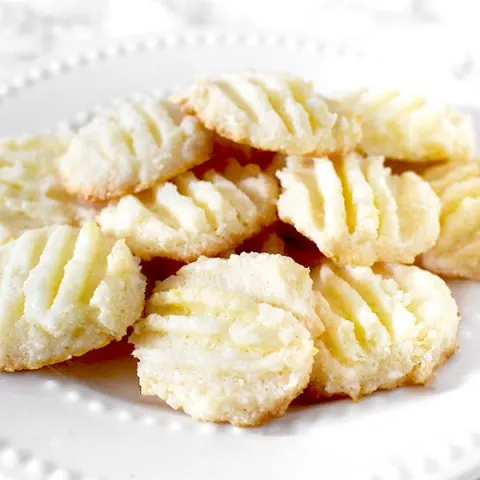
Biscoitos de Maizena are Brazilian cornstarch cookies that often feature coconut.
Ingredients
- 1 ⅔ cups cornstarch (260 grams)
- ⅓ cup all-purpose flour (45 grams)
- ⅔ cup white sugar (135 grams)
- 3 tablespoons grated coconut, optional
- ¼ teaspoon salt
- ¾ cup oil* (175 milliliters)
- 1 teaspoon vanilla
Instructions
- Preheat your oven to 375°F or 190°C.
- Whisk together cornstarch, flour, sugar, optional coconut, and salt in a mixing bowl
- Add oil and vanilla. Mix to combined.
- Roll dough into balls and place on a baking sheet lined with parchment paper. Lightly flatten with a fork.
- Bake for 7 to 10 minutes or until cookies are slightly colored on the bottom and white on top.
- Let cool for 3 minutes before moving to a cooling rack.
Notes
*Click here to jump to notes on oil
Recommended Products
Some of the links below are affiliate links, which means that if you choose to make a purchase, I will earn a small commission. This commission comes at no additional cost to you.
Nutrition Information:
Yield:
30Serving Size:
1Amount Per Serving: Calories: 102Total Fat: 6gSaturated Fat: 1gTrans Fat: 0gUnsaturated Fat: 5gCholesterol: 0mgSodium: 20mgCarbohydrates: 12gFiber: 0gSugar: 5gProtein: 0g
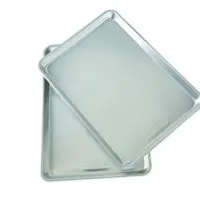
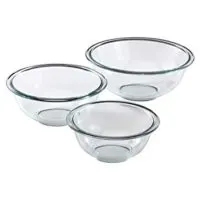
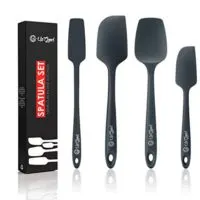
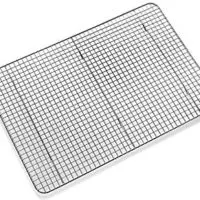
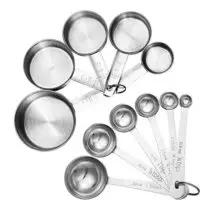
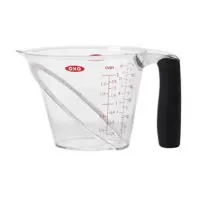
Linda
Sunday 1st of September 2024
Great recipe as is. But also terrific as a base to up some flavor. Tried with coconut oil, lime zest and almond instead of vanilla extract - delish. For a tea, used finely chopped lime basil leaves and this was a huge hit.
ElissaBeth
Monday 9th of September 2024
I'm really glad to hear that you enjoyed the cookies so much ❤️
Lita Lee
Wednesday 22nd of February 2023
I tried 'Brazilian Sweet Gnocchi cookies' from a Brazilian Bakery recently, and they were so good, I want to replicate them. This sounds like the ingredients it tasted like, except they were shaped in small oval shaped bites, and I am thinking of substituting potato starch for the cornstarch. Is this a reasonable substitute?
ElissaBeth
Wednesday 1st of March 2023
Yeah, you shouldn't have any problem using potato starch instead of cornstarch :)
Sue
Thursday 4th of July 2019
They came out wonderful! Thank you for the dairy free recipe :)
ElissaBeth
Monday 22nd of July 2019
I'm glad you liked them! My pleasure :)